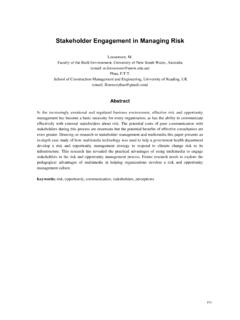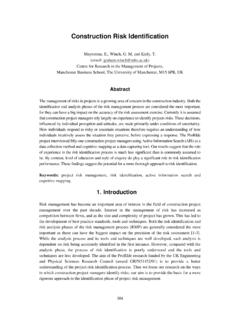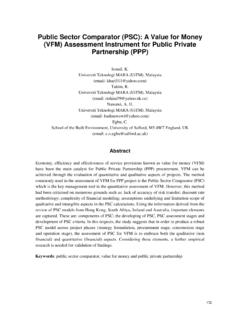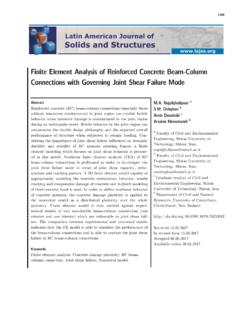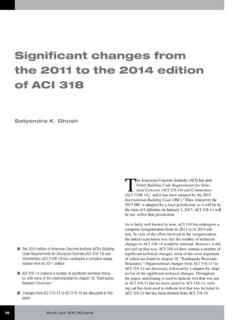Transcription of REUSE OF EXISTING PILES IN BUILDING RECONSTRUCTION …
1 The 2005 World Sustainable BUILDING Conference, 09-023 Tokyo, 27-29 September 2005 (SB05 Tokyo). REUSE OF EXISTING PILES IN BUILDING RECONSTRUCTION . AND ITS environmental EFFECTS. 1. Yasunori TSUBAKIHARA 2. Kiyoshi YAMASHITA. 1. Research & Development Institute, Takenaka Corporation, 1-5-1 Ohtsuka, Inzai, Chiba 270-1395, Japan, 2. Research & Development Institute, Takenaka Corporation, 1-5-1 Ohtsuka, Inzai, Chiba 270-1395, Japan, Keywords: EXISTING pile, REUSE , case study, reduction in environmental impact, borehole sonar Summary This paper presents two case studies on REUSE of EXISTING cast-in-place concrete PILES including EXISTING underground structures in BUILDING RECONSTRUCTION in Tokyo and Osaka, Japan. The main contents are how to deal with the EXISTING PILES in structural design and the evaluation of the supporting capability, namely integrity, durability and bearing capacity of the EXISTING PILES .
2 It is expected that settlement stiffness of the EXISTING pile is larger than that of the newly constructed pile due to loading hysteresis. In the two cases, the difference in settlement stiffness between the EXISTING and newly constructed PILES was obtained from pile loading tests. Using the different settlement stiffness, we made an overall settlement calculation of the BUILDING with foundation and PILES . According to the stress distribution obtained from the settlement calculation, we designed the mat foundation and the reinforcement of EXISTING foundation beams. Trial calculation was made for evaluating an amount of reduction in pile input-resources. The reduction is brought by the REUSE of EXISTING PILES instead of a part of newly constructed PILES . A new technique for checking out the pile-shaft integrity, namely borehole sonar, is also introduced.
3 We confirmed its validity through site measurement tests. 1. Introduction EXISTING PILES are usually removed in the case that they are obstructive when a new foundation is designed by leaving such PILES as they are. However, they are pulled out of the ground with difficulties and may loosen the ground when pulled out. It results in a lowering of the bearing capacity of adjacent PILES installed newly in many cases. Besides, removed PILES have to be disposed as construction wastes. REUSE of EXISTING PILES , which is capable of the reduction in pile input-resources, yields not only the reduction in the construction cost and the shortening of the term of works but also the reduction in environmental impact. Therefore, REUSE of EXISTING PILES in BUILDING RECONSTRUCTION is very important for structural sustainability [1].
4 In view of the social situation for environmental problems, BUILDING Contractors Society of Japan [2] published the guidance for utilization of EXISTING PILES . This paper introduces the outlines of two case studies on REUSE of EXISTING cast-in-place concrete PILES in Japan. The results of trial calculation of its environmental effects are also presented for reference. Besides, a new pile-shaft integrity technique for investigating the configuration of pile cross-section, namely borehole sonar, is introduced. 2. Characteristics of Case Studies on Pile REUSE Table 1 shows the characteristics of the two case studies on REUSE of EXISTING cast-in-place concrete PILES . The pile construction methods were caisson type pile method and overall casing method. For the two cases, the foundation was formed by the combination of EXISTING PILES and newly constructed PILES .
5 Rapid pile loading tests, those are relatively simple in operation, were adopted for the two cases to investigate the settlement stiffness of the PILES . However, conventional static pile loading tests are more advantageous in some cases when checking the designed ultimate bearing capacity of a pile. The method of pile loading should be selected according to the situation on the occasion of investigation. - 2675 - The 2005 World Sustainable BUILDING Conference, Tokyo, 27-29 September 2005 (SB05 Tokyo). Table 1 Characteristics of Case Studies on REUSE of EXISTING Cast-in-Place Concrete PILES [3]. Case Construction Old Survey of Use Method of Total Nos. for Rapid No. Method BUILDING EXISTING PILES EXISTING PILES Numbers Loading Test 1 Caisson Type Constructed In 1994 Support Vertical 14 EXISTING , 1 EXISTING , Pile Method in 1972 Load 8 New PILES 1 New PILES 2 Overall Casing Constructed In 1996 Support Vertical, 157 EXISTING , 1 EXISTING Pile Method in 1971 (Pre.)
6 In 1994) Horizontal Loads 90 New PILES (Pre. 1 Exist.). 3. Case Study on Pile REUSE in Tokyo (Case 1). BUILDING and Ground Conditions [4,5]. Two reinforced concrete buildings constructed in 1972 were located at the construction site of a proposed new ten-storied BUILDING in Chiyoda-ku, central part of Tokyo. One BUILDING in the northern part of the site had four stories above ground and two stories underground, and was supported by large diameter cast-in- place concrete bell PILES . The other BUILDING in the southern part of the site had six stories above ground and one story underground, and was supported by cast-in-place concrete PILES . The new ten-storied, 48 m high BUILDING has three stories underground, and its floor area is about 37 m by 50 m as shown in Figs. 1 and 2. The foundation in the southern part of the new BUILDING is a raft foundation.
7 In the northern part of the new BUILDING , EXISTING cast-in-place concrete bell PILES were reused as a part of the foundation. The EXISTING PILES were designed to support only vertical loads since seismic lateral loads had not been fully taken into account in their past design. The entire seismic lateral loads were designed to be supported by newly constructed PILES . Therefore, eight new cast-in-place concrete bell PILES were added to 14 EXISTING PILES , as shown in Fig. 2. For both the exiting and new PILES , the shaft diameter was m to m and the toe diameter was m to m. The EXISTING and new PILES were connected to a m thick reinforced concrete mat slab to cope with eccentricity of the PILES and columns. Northern Southern part part Ground surface Newly constructed PILES Raft foundation EXISTING PILES 30m 20m 50m Figure 1 Schematic of new BUILDING [4] (Case 1).
8 30m 6 7. 3 8. 2 5 9. 37m 4 Statnamic Rapid . 10 Load tested 11. 13 12. 14. EXISTING PILES Newly constructed PILES Figure 2 Layout of EXISTING and newly constructed PILES [4] (Case 1). - 2676 - The 2005 World Sustainable BUILDING Conference, Tokyo, 27-29 September 2005 (SB05 Tokyo). Soil profiles are shown in Fig. 3, together with the schematics of rapid loading test PILES mentioned later. Those were obtained from the soil investigation at the bottom of the second basement floor of the old BUILDING which was about 10 m deep from the ground surface. The pile toes were embedded in the very dense sand layer. Boring SPT Boring SPT. log N-value log N-value 0 50 0 50. 10. Clayey Clayey sand sand Depth from ground surface(m). Sand Sand Clay 20 Sand Silty clay Sand Silty clay Silty clay Clay Clay Sand and Sand and gravel Over gravel Over 50 50.
9 30. (a) EXISTING pile (b) Newly constructed pile Figure 3 Soil conditions and schematics of load-tested PILES [4] (Case 1). Investigation of EXISTING PILES [4,5]. When reusing EXISTING PILES , it is necessary to guarantee the quality of the pile materials including their durability during the lifetime. To assure the quality of the pile materials, several kinds of tests were conducted. Sonic integrity testing using a low-strain method was conducted for all 14 EXISTING PILES to investigate their soundness and lengths (see Photo. 1). In the tests, any severe defect was not detected in the pile bodies. The validity of the values of pile lengths estimated from the test results was assessed by selecting three EXISTING PILES whose lengths were known by means of core-borings of the pile concrete (see Photo.)
10 2). To investigate the durability of the pile materials, carbonation testing of concrete, compressive testing of concrete and tensile testing of reinforcing bars were conducted. In the carbonation testing, the degree of carbonation was evaluated by spraying a mixture of 1 % phenolphthalein and 99 % ethyl alcohol onto the pile-top surface of the selected six PILES (see Photo. 3). Since those portions underwent a color change to red, it was judged that the pile concrete was not carbonated. 18 compressive tests were conducted on the concrete core specimens sampled from the three PILES mentioned above (Photo. 2), and the compressive strength obtained from the tests was more than the design strength of MPa. Six specimens of reinforcing bars were cut off from the top part of the selected two PILES , and the tensile strength obtained from the tests was more than the design strength of 490 MPa.




